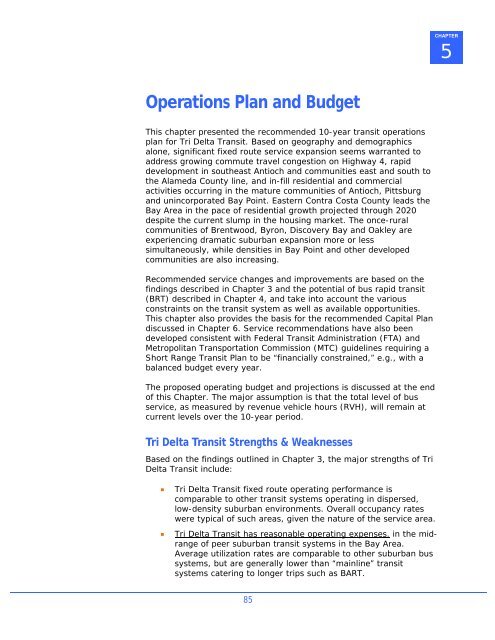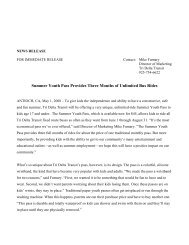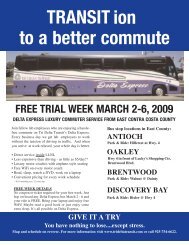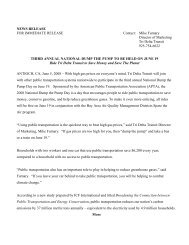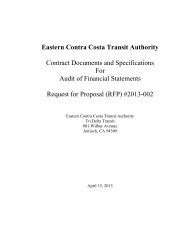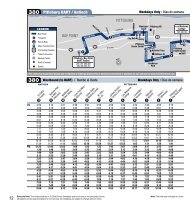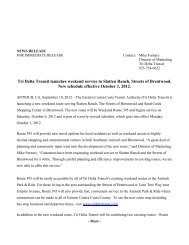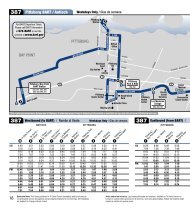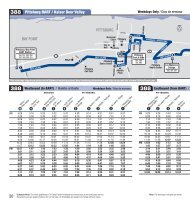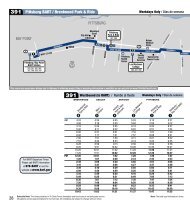to view Short Range Transit Plan FY 2007/2008 - Tri Delta Transit
to view Short Range Transit Plan FY 2007/2008 - Tri Delta Transit
to view Short Range Transit Plan FY 2007/2008 - Tri Delta Transit
You also want an ePaper? Increase the reach of your titles
YUMPU automatically turns print PDFs into web optimized ePapers that Google loves.
CHAPTER5Operations <strong>Plan</strong> and BudgetThis chapter presented the recommended 10-year transit operationsplan for <strong>Tri</strong> <strong>Delta</strong> <strong>Transit</strong>. Based on geography and demographicsalone, significant fixed route service expansion seems warranted <strong>to</strong>address growing commute travel congestion on Highway 4, rapiddevelopment in southeast Antioch and communities east and south <strong>to</strong>the Alameda County line, and in-fill residential and commercialactivities occurring in the mature communities of Antioch, Pittsburgand unincorporated Bay Point. Eastern Contra Costa County leads theBay Area in the pace of residential growth projected through 2020despite the current slump in the housing market. The once-ruralcommunities of Brentwood, Byron, Discovery Bay and Oakley areexperiencing dramatic suburban expansion more or lesssimultaneously, while densities in Bay Point and other developedcommunities are also increasing.Recommended service changes and improvements are based on thefindings described in Chapter 3 and the potential of bus rapid transit(BRT) described in Chapter 4, and take in<strong>to</strong> account the variousconstraints on the transit system as well as available opportunities.This chapter also provides the basis for the recommended Capital <strong>Plan</strong>discussed in Chapter 6. Service recommendations have also beendeveloped consistent with Federal <strong>Transit</strong> Administration (FTA) andMetropolitan Transportation Commission (MTC) guidelines requiring a<strong>Short</strong> <strong>Range</strong> <strong>Transit</strong> <strong>Plan</strong> <strong>to</strong> be “financially constrained,” e.g., with abalanced budget every year.The proposed operating budget and projections is discussed at the endof this Chapter. The major assumption is that the <strong>to</strong>tal level of busservice, as measured by revenue vehicle hours (RVH), will remain atcurrent levels over the 10-year period.<strong>Tri</strong> <strong>Delta</strong> <strong>Transit</strong> Strengths & WeaknessesBased on the findings outlined in Chapter 3, the major strengths of <strong>Tri</strong><strong>Delta</strong> <strong>Transit</strong> include:• <strong>Tri</strong> <strong>Delta</strong> <strong>Transit</strong> fixed route operating performance iscomparable <strong>to</strong> other transit systems operating in dispersed,low-density suburban environments. Overall occupancy rateswere typical of such areas, given the nature of the service area.• <strong>Tri</strong> <strong>Delta</strong> <strong>Transit</strong> has reasonable operating expenses. in the midrangeof peer suburban transit systems in the Bay Area.Average utilization rates are comparable <strong>to</strong> other suburban bussystems, but are generally lower than “mainline” transitsystems catering <strong>to</strong> longer trips such as BART.85


